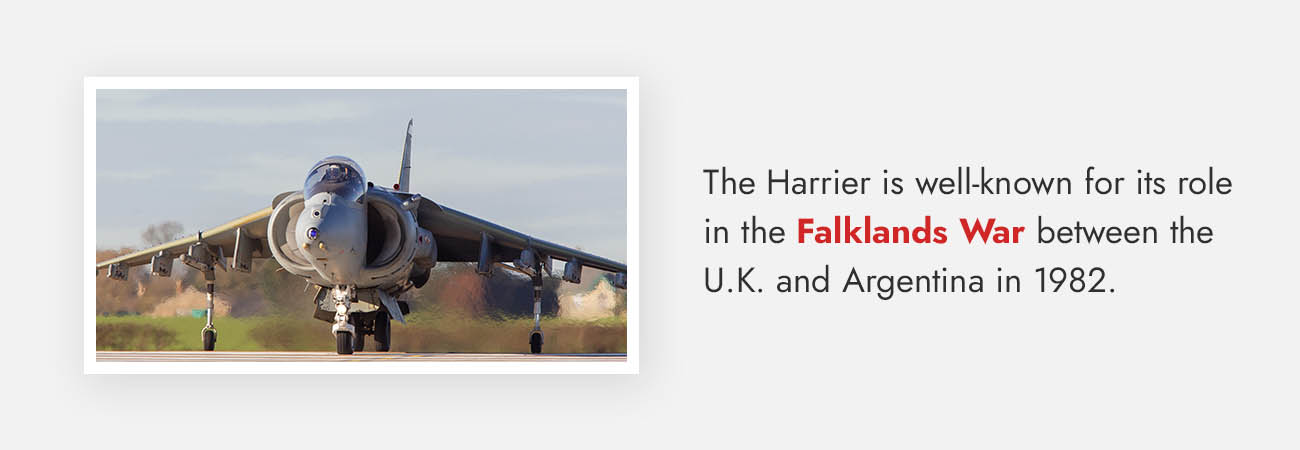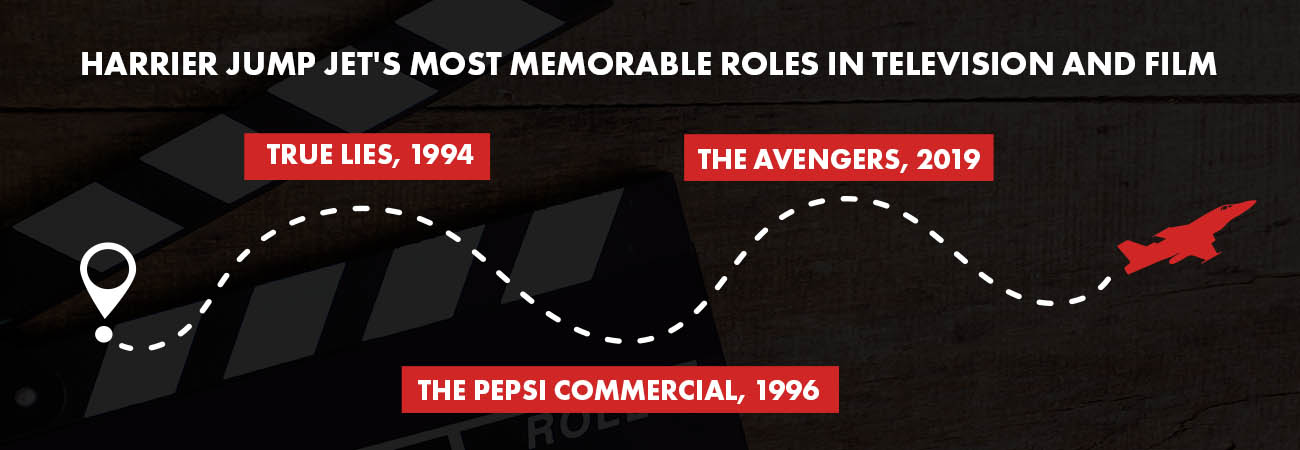
History of The Harriet Jumper Jet

The History of the Harrier Jump Jet
The Harrier jet was a true feat in the history of aircraft engineering. Its innovative engine design and unique landing and takeoff capabilities made it a prized gem among the United States Marine Corps and Royal Air Force alike. Designers also created a realistic replica of the Harrier Jump Jet that mirrors the original aircraft. This fabricated jet made multiple appearances on the big screen, including “True Lies,” “Avengers” and even a Pepsi commercial.
What if we told you that you could see this replicated Harrier jet for yourself? Thanks to the diligent restoration efforts of the Volo Museum, you can!
This exhaustive guide to the Harrier Jump Jet is twofold. We'll first cover the history of this aircraft, including its production, design and military use. Then we'll explore a replica of the jet and its appearances in some of Hollywood's most iconic films. Settle in as we take you on an adventure of how the legendary Harrier came to be — and where it is now.
An Overview of the Harrier Jet
At the end of World War II, North Atlantic Treaty Organization (NATO) strategists discovered that the large runways used for fighter jets were extremely vulnerable to conventional and nuclear attacks. One surprise assault by ground forces or bombers could largely diminish the military's response abilities.
A clear solution to this phenomenon was the creation of military aircraft with vertical/short takeoff and landing (V/STOL) capabilities. Throughout the 1950s, various defense contractors in France, Great Britain and the U.S. experimented with several V/STOL systems in hopes of finding the most successful option. The Harrier jet would be the one to get it right.

The Harrier is a series of jet-powered, military fighter aircraft with V/STOL abilities. In other words, these jets didn't require long runways to fly — they could take off and land vertically or on short runways.
The beauty of V/STOL aircraft was that it could operate from locations like main roads, motorways and forest clearings, concealed under camouflage nets between missions. This capability made Harrier jets nearly impossible to locate and destroy.
The Harrier was initially developed in Britain to operate from improvised bases — like near forest clearings and car parks — eliminating the need for large air bases that were common targets for tactical nuclear weapons. Later, the design would be adapted for use by aircraft carriers.
Achieving V/STOL technology took years of research and development. The Harrier was the only successful V/STOL design of the many attempts during that era. It was known for its modern style, unlike most attack aircraft from the Western post-World War II era, which were generally supersonic.
The Harrier's Innovative Engine Design
As military strategists were desperately searching for the right V/STOL solution, they eliminated propeller-driven and tilt-rotor systems from the running due to their slower speeds. The clear answer was jet-powered aircraft — however, a significant barrier stood in the way. The thrust needed for vertical takeoff and landing substantially exceeded that required for cruise. As a result, the airframe had to carry the large dead weight of either a far bigger engine or auxiliary lifting engines.
Using a turbofan vectored-thrust engine, the Harrier directed its engine thrust downward using rotatable exhaust ports for vertical takeoff. It could seamlessly take off and land vertically since the engine created a stream of fast-traveling air through nozzles.
The jet engine could generate a powerful air stream by moving air through the low-pressure compressor system and fan. Some of the air is channeled into the high-pressure compressor system. The remaining air turns into a cold stream of air, which funnels to a set of nozzles at the front of the engine, producing half of the engine thrust. The engine then directs a hot air stream into a set of nozzles mounted at the rear of the engine, creating the other half of the thrust.
Thanks to this advanced design, the jet didn't require traditional runways and could carry various weaponry, including bombs, rockets, air-to-surface missiles and air-to-air missiles.
Production Timeline
The Harrier underwent a lengthy, complex design journey before the aircraft was refined for military use. As time went on, Harrier jets were manufactured with more powerful engines and higher-quality sensors.
Hawker Siddeley, a British manufacturing company, originally developed the Harrier jet in the 1960s. However, prototyping and testing began as early as the late 1950s.
Here's a condensed timeline of the Harrier's production and testing process:
- 1957: Hawker Siddeley began working on a vertical take-off warplane, which was named the “P.1127.”
- 1960: The company developed and flew two prototypes of the P.1127.
- 1964: Hawker Siddeley created and flew an upgraded version of the P.1127, calling it the “Kestrel.”
- 1965: After evaluating the Kestrel in 1965, the Royal Air Force ordered an upgraded version of the Kestrel. While initially designated the P.1127(RAF), it would eventually be named “Harrier” in 1967.
- 1966: The Harrier jet's first flight took place on August 31, 1966, after an extensive period of development and testing. The Royal Air Force ordered 60 Harrier jets into production within a year of this first flight.
- 1969: In the late 1960s, the U.S. and British governments discussed the possibility of manufacturing Harriers in America. McDonnell Douglas — an American aerospace manufacturing corporation — partnered with Hawker Siddeley in 1969 to prepare for U.S. production.
- 1971: In the 1970s, the U.S. procured the jet as the AV-8A. The AV-8A Harrier is known as the first-generation version of the aircraft. It was used by multiple air forces, including the U.S. Marine Corps and the Royal Air Force.
- 1980: The British Aerospace Sea Harrier was developed in 1980. The naval strike and air defense attack jet derived from the first-generation Hawker Siddeley Harrier. This new naval attack jet featured anti-ship missiles and corrosion-resistant alloys to prevent saltwater damage. Both the Indian Navy and the Royal Navy operated the Sea Harrier.
- 1985: McDonnell Douglas developed the second-generation Harrier — the AV-8B Harrier II — in the U.S. in 1985.
Once the 21st century rolled around, most of the first-generation Harriers had been removed from production. Many operators chose to procure the second-generation Harriers as replacements.
The Harrier Jet's Role in Combat

The Harrier is well-known for its role in the Falklands War between the U.K. and Argentina in 1982. The Sea Harriers took the primary air defense role, along with a secondary ground attack role. The Hawker Siddeley Harrier GR3 handled the main ground attack operations. Ground-attack versions of the Harrier could carry two 30-millimeter cannons, along with bombs and rockets.
While the Sea Harrier also served in the Balkans conflicts and both Gulf Wars, it's most closely associated with the Falklands War. It was the only fixed-wing fighter aircraft available to defend the British Task Force. The Sea Harriers took down 20 enemy aircraft and helped launch ground attacks in the same manner as the Harriers used by the Royal Air Force.
Other FAQs About the Harrier Jump Jet
Before we segue into the replica Harrier and its television and film appearances, we'll wrap up with a couple more fun facts about the aircraft.
How Did the Harrier Jet Get Its Name?
The jet was named after the Harrier, a small bird from the prey family.
Are Harrier Jets Still in Use?
After nearly 40 years of service, the AV-8B Harrier II has officially retired from the U.S. Marine Corps. In 2020, the force decided to discontinue its use of this aircraft and transition to the F-35B Lightning II fighter jet.
Iconic Cinematic Appearances by the Harrier Jump Jet
The Harrier Jump Jet is a full-scale fiberglass replica of the original Harrier. Though initially designed for the movie “True Lies,” it eventually found its way back to the big screen for other captivating performances. Below, we'll take you on a journey through some of the Harrier Jump Jet's most memorable roles in television and film.

1. The “True Lies” Jet
If you've ever seen the 1994 blockbuster favorite “True Lies" starring Arnold Schwarzenegger, you might remember the Harrier's show-stopping performance in the film. In the final scene of the movie, Schwarzenegger's character, Harry Tasker, takes the Harrier on an adrenaline-pumping aerial battle that keeps you on the edge of your seat.
The film had people wondering if Schwarzenegger actually piloted a real Harrier jet in the film, and the answer is no. The footage of the jet was a combination of real Harrier footage and visual effects, creating the illusion that Schwarzenegger was operating the aircraft.
Additionally, a mocked-up Harrier was hung from a construction crane for some of the long-range shots of the jet near the skyscraper. The jet was likely hung in front of blue or green screens during close-up scenes of Harry Tasker, Dana Tasker and Salim Abu Aziz.
2. The Pepsi Commercial Jet
The same synthetic Harrier jet also starred in a Pepsi commercial in 1996, but little did anyone know the discord that would ensue.
Pepsi advertised a points-for-prize scheme in its commercial. Customers could purchase Pepsi products and collect points from the labels, then exchange them for prizes like sunglasses and T-shirts. As a joke, the company offered a Harrier jet as a prize for 7 million Pepsi points.
John Leonard — a business student in his twenties at the time — noticed in the fine print that customers could buy Pepsi points for 10 cents each in place of labels. He crunched the numbers and realized he would need $700,000 to purchase the points needed for the jet. Determined to snag the ultimate prize, he called around and convinced five investors to give him the money after explaining his scheme.
However, when Leonard sent Pepsi 15 Pepsi tags and the remaining points in cash, the company refused to deliver the promised Harrier jet on the grounds that the whole thing was a joke. This response led to Leonard suing Pepsi for fraud and breach of contract, arguing that the company made an offer for a unilateral contract to sell the jet for 7 million Pepsi points.
Leonard's lawsuit fizzled out in the end, and the case ultimately ruled in favor of Pepsi. Essentially, the court stated that no objective person could logically conclude the commercial actually offered customers a Harrier Jet.
Additionally, Pepsi updated its commercial and moved the goalpost by increasing the number of points required for the jet from 7 million to 700 million. Who knew a simple Pepsi commercial could whip up so much controversy? The whole fiasco would even inspire the 2022 Netflix documentary series “Pepsi, Where's My Jet?”
What are your thoughts on this case? Are you team Leonard or team Pepsi?
3. The Avengers Jump Jet
After its starring role in the Pepsi commercial, the replica Harrier jet sat in the desert for years, patiently awaiting its next big break. Finally, in 2019, it finished out its career in film with some well-deserved closure. The Harrier Jump Jet went out with a bang with one final role.
Get excited, Marvel fans — the replica jet was pulled from the desert and given a dazzling makeover to prepare it for its role in the beloved film “Avengers.” If you recall the scene where The Hulk smashes into the jet and rips off the wing in a thrilling special effects display, that jet was none other than the replica Harrier. Unsurprisingly, the jet saw some severe damage from this film, and it took two years to repair and rebuild the replica.
Volo Museum's Harrier Jump Jet Restoration Project
So, where is the famous replica of Harrier Jump Jet now, you may ask? Walk through the doors of Volo Museum in Illinois, and you'll come face-to-face with this magnificent artifact. The fabricated aircraft that once appeared in some of the film industry's most intense scenes now sits among our extensive collection of exhibits.
After two years of hard work, time and labor, we successfully restored the replica Harrier jet from 1994, bringing it back to life at our museum. As a tribute to its roles in two major films, the Harrier Jump Jet was restored with markings that mimicked its appearance in “True Lies" on one side. The opposite side of the jet was designed to emulate its appearance in “Avengers.”
The vibrant colors from the meticulous paint job speak to the rich historical essence of the Harrier, and if you look closely, you can even see the dents and imprints from the Hulk. The attention to detail is a true marvel — no pun intended.
So, what are you waiting for? Plan your visit to Volo Museum and soak in the cinematic history.
Visit Volo Museum Today!
Come take a stroll through the aviation exhibit at Volo Museum and see the fascinating Harrier Jump Jet display for yourself. While you're there, you can also check out our host of other attractions, including classic and modern muscle cars, planes, boats, trains, Disney galleries, a military museum and an antique mall.
Whether you're a history whiz or an aircraft guru — or you're simply looking for some entertainment in the Chicago area — we formally invite you to come and check us out. We're open daily from 10 a.m. to 5 p.m., and we'd love to see you there!
Have any questions? Send us a message or give us a call at 815-385-3644.


